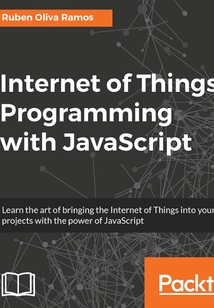首頁 > 計(jì)算機(jī)網(wǎng)絡(luò) >
數(shù)據(jù)庫
> Internet of Things Programming with JavaScript最新章節(jié)目錄
舉報(bào) 

會員
Internet of Things Programming with JavaScript
最新章節(jié):
Summary
LearntheartofbringingtheInternetofThingsintoyourprojectswiththepowerofJavaScriptAboutThisBook?ThisisapracticalguidetohelpyouconfigureandbuildacompletedistributedIoTsystemfromscratchusingJavaScript?UtilizethepowerofNodeandHTML5todevelopwebservicesandacentralizedwebserver,enablinghigh-levelcommunicationbetweenconnecteddevices?ControlallyourconnecteddevicesfromthebrowserbysettingupacommondashboardWhoThisBookIsForThisbookisfordeveloperswhoareinterestedinlearninghowtocommunicatewithconnecteddevicesinJavaScripttosetupanIoTsystem.SomebasicknowledgeofJavaScriptisexpected.HobbyistswhowanttoexplorethepotentialofIoTinJavaScriptwillalsofindthisbookuseful.WhatYouWillLearn?DeveloptheskillstoconnecteddevicespreparedthefieldtointeractwiththedevicesinanetworksystemInternetofThings?Findouthowtoconnectsensorsandactuatorstothedevices?Senddatatoawebserverconnecteddevices?UnderstandInternetofthingsusingwebservicesanddatabase?ConfigureadashboardusingHTML5andJavaScript?Controldevicesconnectedfromadashboard?Monitordifferentdevicesfromthedashboard?BuildanappforasmartphonetocontroldifferentdevicesInDetailTheInternetofThings(IoT)isanentirelynewplatformfordevelopersandengineers,butonethingthatremainsconsistentaswemoveintothisnewworld,aretheprogramminglanguages.JavaScriptisthemostwidelyusedlanguageovertheInternet,andwithIoTgainingmomentum,youwilllearnhowtoharnessthepowerofJavaScripttointeractwithconnecteddevices.ThisbookwillteachyouhowtointeractwithendpointdevicesbydevelopingwebservicesinJavaScriptandalsosetupaninterfacetocontrolallconnecteddevices.Thisbookbeginswithsettingupacentralizedwebserverthatservesasahubforallconnecteddevices.Thebookthenprogressesfurthertowardsbuildingwebservicestofacilitatehigh-levelcommunicationbetweenconnecteddevices.UsingArduinoandRaspberryPiZeroasendpointdevices,thebookwillshowyouhowdevicescancommunicatewitheachother,performawiderangeoftasks,andalsobecontrolledfromacentralizedlocationusingJavaScript.Thebookendswithcreatingahybridapptocontrolthedevicesthatcanberunfromabrowserorinstalledonasmartphone.StyleandapproachThisbookoffersstep-by-stepguidanceonhowtosetupadistributedIoTsystemusingJavaScript.ItwillteachyouhowtointeractwithendpointdevicesbydevelopingwebservicesinJavaScriptandalsosetupaninterfaceforcontrollingallconnecteddevices.
目錄(110章)
倒序
- coverpage
- Internet of Things Programming with JavaScript
- Credits
- About the Author
- www.packtpub.com
- Why subscribe?
- Customer Feedback
- Preface
- What this book covers
- What you need for this book
- Who this book is for
- Conventions
- Reader feedback
- Customer support
- Chapter 1. Getting Started with Raspberry Pi Zero
- Setting up Raspberry Pi Zero
- Connecting to the home network and accessing remotely
- How to install the wireless tools
- Testing the communication
- Updating the package repository
- Remote Desktop
- Configuring a web server
- Testing the PHP installation
- Summary
- Chapter 2. Connecting Things to the Raspberry Pi Zero
- Connectting digital input - sensor DS18B20
- Configuring the one-wire protocol
- Connecting analog inputs using an MCP3008 ADC Converter
- Raspberry Pi GPIO header
- Connecting an RTC
- DS3231 module setup
- Testing the RTC
- I2C device setup
- Putting the real-time clock to final test
- Summary
- Chapter 3. Connecting Sensors - Measure the Real Things
- Measuring flow sensor to calculate the volume of water
- Reading and counting pulses with Arduino
- Calculating water flow rate based on the pulses counted
- Calculating flow and volume of water:
- Measuring the concentration of gas
- Measuring the level of alcohol with a sensor
- Detecting fire with a sensor
- Measuring the humidity for plants
- Measuring the level of water in a recipient
- Measuring temperature humidity and light and displaying data on an LCD
- Detecting motion with a PIR sensor
- Detecting if the door is open with a reed switch
- Detecting who can get in the house with a fingerprint sensor
- Summary
- Chapter 4. Control-Connected Devices
- Making a simple web server with Node.js
- Controlling a relay from a Raspberry Pi Zero using Restful API and Node.js
- Controlling the relay using aREST commands from a web browser
- Configuring Node.js on a computer as a web server
- Monitoring temperature humidity and light using Node.js with Arduino Wi-Fi
- Monitoring temperature humidity and light using Node.js with Arduino Ethernet
- Summary
- Chapter 5. Adding a Webcam to Monitor Your Security System
- Interaction between Arduino and Raspberry Pi
- Arduino interface in Raspian
- Controlling an output connected to Arduino from Raspberry Pi Zero
- Controlling the Arduino board from Python
- Connecting a TTL serial camera to Arduino and saving pictures to a micro SD
- Detecting motion with the serial TTL camera
- Controlling a snapshot from Raspberry Pi
- Controlling your camera from a web page
- Monitoring your USB camera for security in a network
- Summary
- Chapter 6. Building a Web Monitor and Controlling Devices from a Dashboard
- Configuring MySQL database server
- Installing PhpMyAdmin for administrating databases
- Datalogger with MySQL
- Data queries from the database
- Controlling and dimming a LED
- Controlling the speed of a DC motor
- Controlling Lights with electrical circuits
- Other appliances
- Remote access from anywhere to your Raspberry Pi Zero
- Controlling lights and measuring current consumption
- Controlling and monitoring Arduino Wi-Fi and Ethernet shields on connected devices and sensors
- Summary
- Chapter 7. Building a Spy Police with the Internet of Things Dashboard
- Spy microphone that detects noise
- Regulating the current of an AC lamp dimmer
- Controlling access with an RFID card
- Detecting smoke
- Building an alarm system using the Raspberry Pi Zero
- Monitoring the climate from a remote dashboard
- Summary
- Chapter 8. Monitoring and Controlling Your Devices from a Smart Phone
- Controlling a relay from a smart phone using APP Inventor
- Creating our first application
- Reading JSON response in Android Studio using ethernet shield
- Android application
- Controlling a DC motor using an Android Application
- Controlling outputs from android using your Raspberry Pi Zero
- Controlling outputs with Raspberry Pi via Bluetooth
- Summary
- Chapter 9. Putting It All Together
- Integrating the system - development projects
- Solar power monitor circuit
- Automatic irrigation system with a soil sensor
- Arduino water-level controller
- Bluetooth based home automation
- Controlling access with a matrix keyboard
- Controlling the door lock with a keypad
- Integrating the system control with relays and devices
- How to set up the power supplies
- Summary 更新時(shí)間:2021-04-02 20:31:54
推薦閱讀
- 數(shù)據(jù)挖掘原理與實(shí)踐
- Oracle RAC 11g實(shí)戰(zhàn)指南
- Libgdx Cross/platform Game Development Cookbook
- 基于OPAC日志的高校圖書館用戶信息需求與檢索行為研究
- 數(shù)據(jù)庫設(shè)計(jì)與應(yīng)用(SQL Server 2014)(第二版)
- LabVIEW 完全自學(xué)手冊
- SIEMENS數(shù)控技術(shù)應(yīng)用工程師:SINUMERIK 840D-810D數(shù)控系統(tǒng)功能應(yīng)用與維修調(diào)整教程
- 大數(shù)據(jù)分析:R基礎(chǔ)及應(yīng)用
- 從Lucene到Elasticsearch:全文檢索實(shí)戰(zhàn)
- Access 2010數(shù)據(jù)庫應(yīng)用技術(shù)教程(第二版)
- 數(shù)據(jù)會說話:活用數(shù)據(jù)表達(dá)、說服與決策
- 精通Neo4j
- 產(chǎn)品經(jīng)理數(shù)據(jù)修煉30問
- INSTANT Windows Powershell 3.0 Windows management Instrumentation Starter
- 大數(shù)據(jù)架構(gòu)師指南
- 機(jī)器視覺原理與案例詳解
- 數(shù)據(jù)分析師寶典
- 云存儲安全:大數(shù)據(jù)分析與計(jì)算的基石
- 計(jì)算機(jī)視覺與深度學(xué)習(xí)實(shí)戰(zhàn):以MATLAB、Python為工具
- 數(shù)據(jù)流上頻繁模式和高效用模式挖掘
- Oracle精髓(原書第5版)
- 數(shù)據(jù)結(jié)構(gòu)習(xí)題解答與實(shí)驗(yàn)指導(dǎo)(第四版)
- 大數(shù)據(jù)技術(shù)體系與開源生態(tài)
- Mastering Unit Testing Using Mockito and JUnit
- MySQL數(shù)據(jù)庫基礎(chǔ)實(shí)例教程
- 消息設(shè)計(jì)與開發(fā)
- 數(shù)據(jù)庫技術(shù)及應(yīng)用
- XNA 4.0 Game Development by Example Beginner's Guide(Visual Basic Edition)
- 數(shù)據(jù)分析咖哥十話:從思維到實(shí)踐促進(jìn)運(yùn)營增長
- Hadoop大數(shù)據(jù)挖掘從入門到進(jìn)階實(shí)戰(zhàn)(視頻教學(xué)版)

